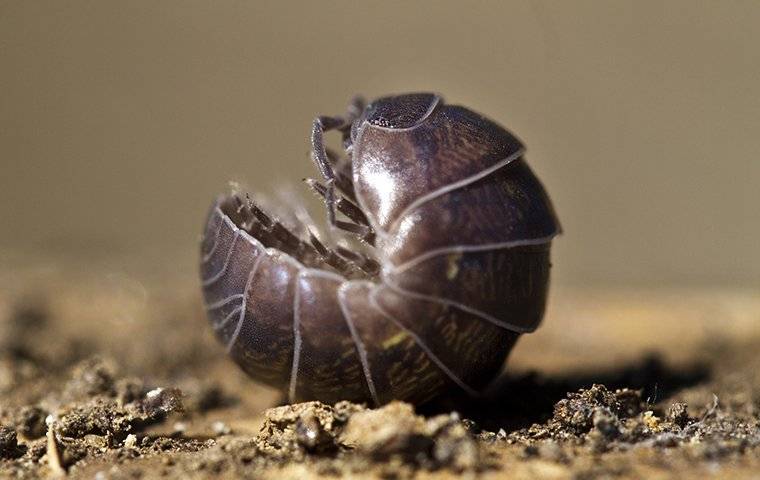
Pill Bugs
Description
The pill bug is ½ inch thick and is gray in color. Commonly known as "rolly pollies", pill bugs are generally very active at night and feed on decaying plant matter. When a large number occurs outside a foundation, numerous pill bugs may find their way in where they die quickly from dehydration. They can, however, survive well in damp basements, warehouses, and crawlspaces. They have been found to live in homes where a constant source of moisture is available due to a water leak.

Pill bugs are a land scavenger and have a protective, hard coating. This shell is comparable in structure to that of a shrimp. The exoskeleton casts occasionally in the middle of the life of a pill bug. These small insects rarely develop more than an inch and range from darker pink tones to silvery blue tones. They can also take the usual names of "potato bugs" or "rolly pollies".
Pill bugs prefer humid environments and are found under the objects found in moist soil and in garbage, mulch and other types of vegetative debris. Pill bugs have a place with the woodlouse family. They are one of only a handful of subspecies that can move in a ball when they are undermined. This cautious position is a method to guarantee.
Like other creepy crawlies, pill bugs can be spotted regularly hovering in moist areas. They impart numerous attributes to scavengers, including comparative living spaces. They are discovered all over the world and occupy numerous American, Canadian and European patios and scenes. These animals are pervasive in New Zealand.
Pill bug invasions generally occur in nurseries, where perfect ecological conditions intensify. They live under rocks, we also see them under leaves and mulch, but they depend on conditions in which heat and stickiness prevail. They can also be discovered near water. These water-based conditions help maintain water loss from their bodies, which they can not handle independently of anyone.
When they feel weak, they move into little balls that offer the final insurance. Other woodlice do not do this. In any case, an inherited cross species known as the millipede pill shares this characteristic and is approximately identified with pill bugs. This stored component is known as conglobation and maintains its core temperature.
How To Prevent/Control
Invasions of the pill bug in the interior occurs when the conditions support a large number of these crustaceans. Treatments can provide short-term relief, but correcting such conditions is key to long-term success. Thick soil covers, such as ivy, “monkey” grass, etc. They should not be placed next to or near a foundation as it provides a safe place for different types of insects, spiders, mice, and other pests. Items in contact with the floor should be removed whenever possible.
Firewood, lumber, and other stored items of this type should be piled up from the ground on supports away from the building. External cracks and holes should be sealed, especially along the foundation. The drip holes can be “closed” by filling pieces of wire mesh or screening in the openings. Treatments are generally not necessary because pill bugs dry out quickly and die.
Customer Reviews
-
“He spent time educating us about "pests" and provided information regarding services with GoForth.”- Joyce C.
-
“Texted me before coming. Worked with me playing musical rooms with my dogs. I'll see how things are.”- Constance E.
-
“Amazing response time, reasonable prices, great customer service. Tevin was thorough and confident in his plan to fix our horrendous fire ant problem. We have had negative experiences with prior exterminators and probably waited way too long to call Go-For”- Ashley T.
-
“- Toya B.
We have been customers for almost 7 years for a reason. Our technician is the best. He always knows exactly how to address whatever pest has decided to bother us. We have referred them to many of our neighbors. Well worth the cost not to have to worry a
” -
“Answered all my questions and I felt their pricing was very reasonable.”- Deborah J.
-
“Brian went above and beyond what was expected, and I hope I get him again as my technician for future services!”- Tam L.
-
“He was thorough with inspecting and treating our home, which I really appreciate, and he took the time to answer my many questions.”- Jasmine B.
-
“Love the detailed summary and pics of what he did and saw! And did I mention how wonderful Olivia was to get us all set up?!!”- Beechy A.


Over the years, we’ve boiled down our mission to a core set of values:
-
Give A CrapDelight others by owning your role and saying yes. Take pride in how you appear & act & every other detail of the job. Be on time, attentive, & enthusiastic. Act as if the buck stops with you on every aspect of the job.
-
Chase PerfectionChase Perfection, knowing full well we will not reach it, but along the way we will catch excellence. Have a sense of urgency; Go-Forth Time - right now might be the only time you have to get it right.
-
Dig Deeper
Be an action-oriented professional that makes decisions based on evidence rather than stories & assumptions. Stay curious. Data can speak for itself.
Understand the cause of the fire rather than rushing to extinguish it.
-
Fight For SimplicityKeep it simple & consistent. Focus on how things should be done every time.
-
Face It, Fix ItConfront challenges directly and address issues head-on. A bias for action and powerful conversations drive our progress. It’s about getting it right rather than being right.
-
Grow!Growth is our purpose. Growing as people & growing our business.